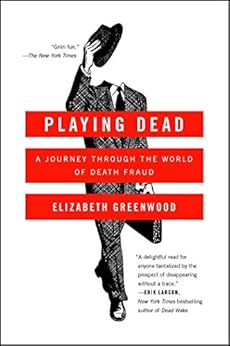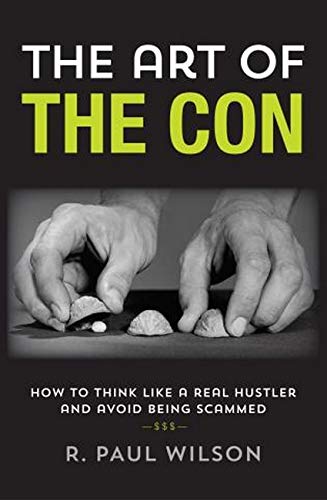Shelf Care: Fake It 'til You Make It
Welcome to Shelf Care, where I review three books related by a theme. These aren't necessarily the latest releases, but are hopefully books you can't believe you missed.This column's theme: Fake It 'til You Make It: people making stuff up to take your stuff away.Let’s face it – if working to get what you wanted was easy or fair, I wouldn’t have any of the books in this month’s column because nobody would be motivated to cheat or take shortcuts to get what they want. Fortunately for me, we live in a world where the unethical abound and just can’t keep their mouths shut, which is helping these authors to describe how scams work, and letting us what to watch out for (or, sometimes, how to participate). So, if you’ve got an interest in true crime, keeping your stuff, or keeping somebody else’s stuff, might I recommend the following:So if you like:Real life soap opera twistsGetting away from it allOccasional insurance fraudLife after deathYou might like: Playing Dead :A Journey Through the World of Death Fraud, by Elizabeth GreenwoodOverviewIf you’ve ever wondered what’s involved in faking your own death (and who hasn’t?), Elizabeth Greenwood digs in to the subject, examining everything from the surprising legality, to the staging, to life after death, and the effects it has on people left behind.Sample passage
Playing Dead :A Journey Through the World of Death Fraud, by Elizabeth GreenwoodOverviewIf you’ve ever wondered what’s involved in faking your own death (and who hasn’t?), Elizabeth Greenwood digs in to the subject, examining everything from the surprising legality, to the staging, to life after death, and the effects it has on people left behind.Sample passage
Death fraud can be big business in many of these obscure locales, not just for the claimant but also for the local economy. A small but thriving infrastructure exists to assist you in your tragic accident. A witness’s testimony is for sale, as is a doctor’s signature on your death certificate. In countries such as Haiti and Nigeria, enterprising middlemen streamline the operation for you. There you can buy what is known in the biz as a “death kit.” Marquez elaborates what you can get for a few hundred bucks: “A death kit includes a copy of the fake death certificate, a burial permit, photographs of the actual burial plot. They will often make a video of the funeral Mass, of people crying and wailing, and the funeral procession down the street. They are basically performing the ceremony.” Rambam sums it up: “A death kit is basically, ‘Step right up and buy your all-inclusive fraud package!’ It’s a shell corporation for fraud.”How much you are willing to pay will sometimes determine the quality of the amateur dramatics at your funeral, such as how many mourners you can cast. Marquez remembers one video from a Nigerian case: “They had the body lying in the middle of the bed, and mourners were chanting in a circle. When they came onto the screen, it looked like there were hundreds of people. But when I paid closer attention, I noticed that the mourners were the same villagers, circling in and out of the frame, and just changing clothes each time.” He laughs. “There were probably around fifteen people there instead of one hundred.” Sometimes, he adds, you can see the corpse sweat or the deceased’s chest rising and falling in the coffin. Most often, and more conveniently, the body will be cremated.
TakeawayIt was really interesting to see how what has become a standard soap opera trope actually works out in real life. Greenwood delivers her well paced look in to death fraud with a slightly snarky tone and a thorough investigation of real world cases where it fell apart (although as she points out, anyone who was successful at it would naturally never be found) and of the people who work in the industry, both helping and hunting those who have apparently died. If you’re a fan of true crime or have ever wondered what it would be like to get away from it all, Playing Dead is definitely worth a read.Or if you like:ScamsFinding the twistBeing glad it’s not your moneySchadenfreudeYou might like: Duped! True Stories of the World's Best Swindlers, by Andreas SchroederOverviewIt’s a selection of famous, and some not so famous historical scams, played on audiences large and small.Sample passage
Duped! True Stories of the World's Best Swindlers, by Andreas SchroederOverviewIt’s a selection of famous, and some not so famous historical scams, played on audiences large and small.Sample passage
In 1916, an American named Louis Enricht announced that he’d invented a cheap additive that turned tap water into automotive fuel. While World War I raged in Europe and gasoline sold for a whopping 30 cents a gallon, Enricht claimed that his additive would bring the per-gallon cost down to a single penny.They did—and it worked! Enricht’s demonstrations were so convincing, in fact, that the world-famous automaker Henry Ford offered him millions for the rights to his additive.Actually, Enricht had merely discovered that if you add a very cheap chemical called acetone to water, it will run an engine—for a while. Then it will destroy it. But before anyone found that out, he convinced not only Henry Ford but several other famous American businessmen to give him millions for his worthless invention.
TakeawayThis is a quick read for anybody wondering how scams have worked throughout history. Each scam is broken down into four stages: the setup, the execution, getting caught, and how it really worked. As a reader I found myself trying to guess the twist ending of each scam, to find out things like:
- Why German villagers were literally fishing money out of a lake
- How an inexperienced seaman could possibly win an around the world sailing contest
- What was behind the cheap energy source investors poured millions of dollars into
If you’re a fan of this sort of thing, Schroeder has written a number of other books on scams which are well worth looking up, and they’re all suitable for young adult readers who may be interested in learning about how things that look too good to be true usually are.Or if you like:The movie The StingNot getting ripped offCheatingPractical, if criminal applications of magicYou might like: The Art of the Con: How to Think Like a Real Hustler and Avoid Being Scammed, by R. Paul WilsonOverviewWith his background in magic, R. Paul Wilson has hosted a number of T.V. shows illustrating various cons, and collects forty years of knowledge about various scams and how to avoid them in this book.Sample passage
The Art of the Con: How to Think Like a Real Hustler and Avoid Being Scammed, by R. Paul WilsonOverviewWith his background in magic, R. Paul Wilson has hosted a number of T.V. shows illustrating various cons, and collects forty years of knowledge about various scams and how to avoid them in this book.Sample passage
First, let’s establish that it’s not a “game.” The objective of the hustler is not to offer odds or to pay winners under any circumstances. There are only two possible outcomes, depending on your ability to resist peer pressure and temptation: Either you’ll lose money or you won’t. Street games are theatrical muggings designed to fool people into thinking they have the upper hand, using techniques that have been successfully ripping off suckers for centuries. Many victims are well aware that these games are crooked, but, armed with a little information, they walk up to a game thinking they might be able to “spot the move.” A few minutes later they’re broke and wondering what the hell just happened.
TakeawayOne of the interesting angles of this book, apart from being a history of various scams, is how he he covers how the psychology behind a successful scam. These principles apply in a variety of areas, from things like carnival games, or identity theft, to computer security. His time hosting on the BBC series The Real Hustle provided him with a wealth of stories about actually pulling off some of the cons he describes, and allows him to point out that even when the show returned the money to the victims, some of them refused to believe that they’d been conned, which exacerbates the problem of prosecuting real scams. At times he does get bogged down in the details (I still can’t quite picture how to perform some of the card palming tricks he describes) but it’s still a great book for anyone looking to avoid getting fleeced.So, what other books should be on this list? Leave your thoughts in the comments, and stay tuned for my next column.

